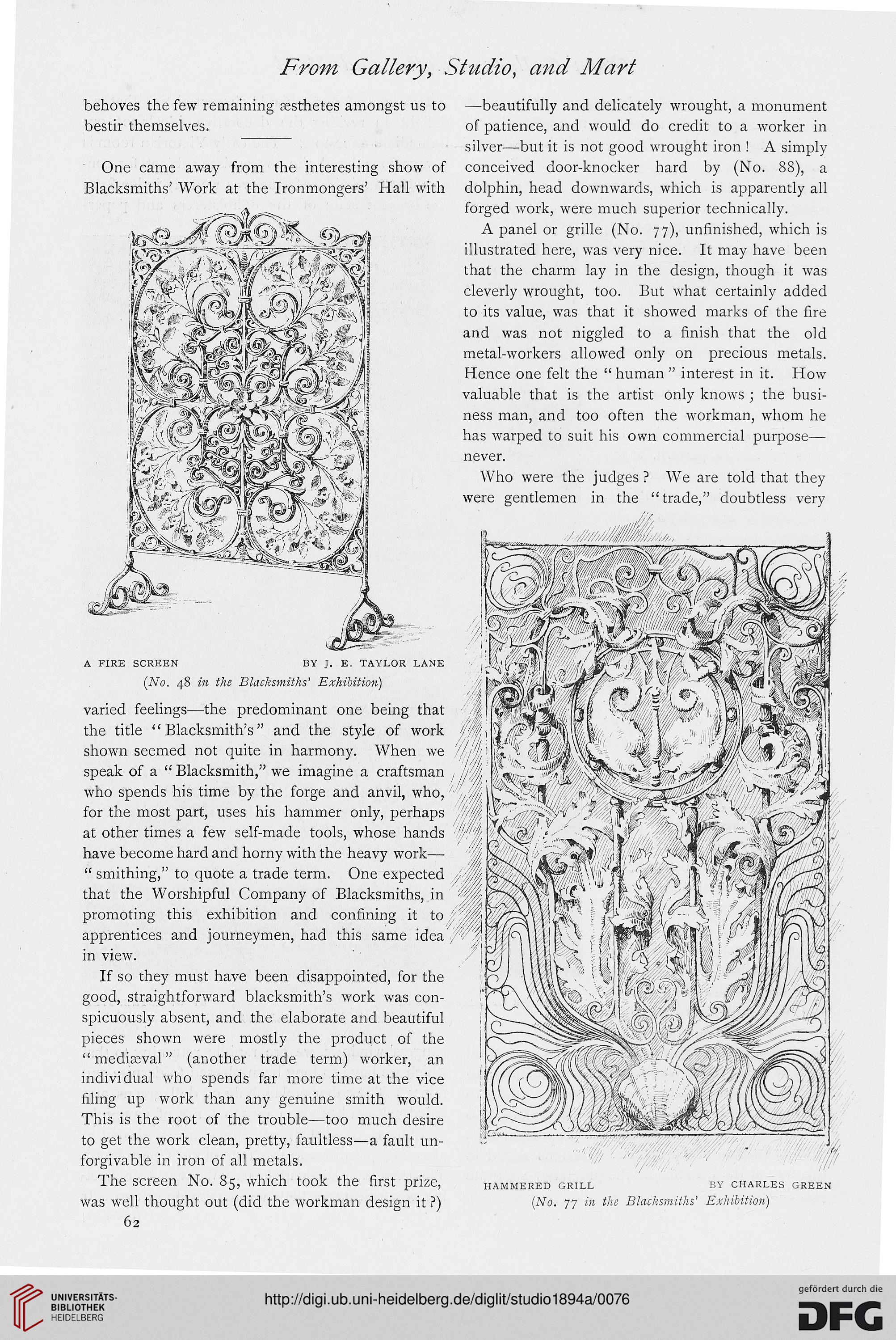From Gallery, Studio, and Mart
behoves the few remaining aesthetes amongst us to
bestir themselves.
One came away from the interesting show of
Blacksmiths' Work at the Ironmongers' Hall with
A FIRE SCREEN BY J. E. TAYLOR LANE
(No. 48 in the Blacksmiths' Exhibition)
varied feelings—the predominant one being that
the title "Blacksmith's" and the style of work
shown seemed not quite in harmony. When we
speak of a " Blacksmith," we imagine a craftsman
who spends his time by the forge and anvil, who,
for the most part, uses his hammer only, perhaps
at other times a few self-made tools, whose hands
have become hard and horny with the heavy work—
" smithing," to quote a trade term. One expected
that the Worshipful Company of Blacksmiths, in
promoting this exhibition and confining it to
apprentices and journeymen, had this same idea
in view.
If so they must have been disappointed, for the
good, straightforward blacksmith's work was con-
spicuously absent, and the elaborate and beautiful
pieces shown were mostly the product of the
" mediaeval" (another trade term) worker, an
individual who spends far more time at the vice
filing up work than any genuine smith would.
This is the root of the trouble—too much desire
to get the work clean, pretty, faultless—a fault un-
forgivable in iron of all metals.
The screen No. 85, which took the first prize,
was well thought out (did the workman design it ?)
62
—beautifully and delicately wrought, a monument
of patience, and would do credit to a worker in
silver—but it is not good wrought iron ! A simply
conceived door-knocker hard by (No. 88), a
dolphin, head downwards, which is apparently all
forged work, were much superior technically.
A panel or grille (No. 77), unfinished, which is
illustrated here, was very nice. It may have been
that the charm lay in the design, though it was
cleverly wrought, too. But what certainly added
to its value, was that it showed marks of the fire
and was not niggled to a finish that the old
metal-workers allowed only on precious metals.
Hence one felt the " human " interest in it. How
valuable that is the artist only knows ; the busi-
ness man, and too often the workman, whom he
has warped to suit his own commercial purpose—
never.
Who were the judges ? We are told that they
were gentlemen in the " trade," doubtless very
(No. 77 in the Blacksmiths' Exhibition)
behoves the few remaining aesthetes amongst us to
bestir themselves.
One came away from the interesting show of
Blacksmiths' Work at the Ironmongers' Hall with
A FIRE SCREEN BY J. E. TAYLOR LANE
(No. 48 in the Blacksmiths' Exhibition)
varied feelings—the predominant one being that
the title "Blacksmith's" and the style of work
shown seemed not quite in harmony. When we
speak of a " Blacksmith," we imagine a craftsman
who spends his time by the forge and anvil, who,
for the most part, uses his hammer only, perhaps
at other times a few self-made tools, whose hands
have become hard and horny with the heavy work—
" smithing," to quote a trade term. One expected
that the Worshipful Company of Blacksmiths, in
promoting this exhibition and confining it to
apprentices and journeymen, had this same idea
in view.
If so they must have been disappointed, for the
good, straightforward blacksmith's work was con-
spicuously absent, and the elaborate and beautiful
pieces shown were mostly the product of the
" mediaeval" (another trade term) worker, an
individual who spends far more time at the vice
filing up work than any genuine smith would.
This is the root of the trouble—too much desire
to get the work clean, pretty, faultless—a fault un-
forgivable in iron of all metals.
The screen No. 85, which took the first prize,
was well thought out (did the workman design it ?)
62
—beautifully and delicately wrought, a monument
of patience, and would do credit to a worker in
silver—but it is not good wrought iron ! A simply
conceived door-knocker hard by (No. 88), a
dolphin, head downwards, which is apparently all
forged work, were much superior technically.
A panel or grille (No. 77), unfinished, which is
illustrated here, was very nice. It may have been
that the charm lay in the design, though it was
cleverly wrought, too. But what certainly added
to its value, was that it showed marks of the fire
and was not niggled to a finish that the old
metal-workers allowed only on precious metals.
Hence one felt the " human " interest in it. How
valuable that is the artist only knows ; the busi-
ness man, and too often the workman, whom he
has warped to suit his own commercial purpose—
never.
Who were the judges ? We are told that they
were gentlemen in the " trade," doubtless very
(No. 77 in the Blacksmiths' Exhibition)




